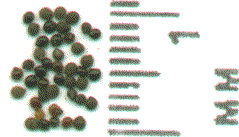|
|
 |
|
This European immigrant is an odorless, branching, annual herb, with stalked, opposite, simple leaves which are clammy-feeling, unwettable, and have a whitish coating on the underside. The first leaves are roughly diamond-shaped and somewhat toothed toward the point, and the later leaves are narrow and toothless. Lamb's-quarters was introduced to the U.S. as a pot-herb and now grows everywhere. It particularly likes disturbed soil, but it's not above growing through the cracks in the sidewalk. It generally grows from 1 to 3 feet tall, though it may reach over twice that height under favorable conditions. There are many similar edible species in this genus. The rule is: if it's odorless, it's food, and if it has a resiny smell, it's a spice. The red tracing in the leaf in the lower right corner in the first photo means that spinach leaf miner larvae live there. It's probably better not to eat those leaves. Collect the young tender plants whole, and then when the stems become tough, collect just the leaves and tender tips. Do not collect Lamb's-quarters growing in artificially fertilized or treated soils. It will absorb pesticides from the soil and is also prone to accumulate high levels of nitrates. (in very much the same way as its' relative, spinach). It also contains high amounts of oxalic acid (also like spinach) and should therefore be consumed in moderation. |

The second photo is about the same view as the first, a month or so later. It now shows part of the lower branches. The new leaves are small and narrow and numerous branches have developed. The leaves can be collected up until the frost kills them, and they never turn bitter, but they do get much smaller later in the season. Use the shoots, leaves and tips in any way that you might use spinach. It tastes a lot like spinach, only milder, with sort of a hint of peapods. Lamb's-quarters is very high in vitamin A, calcium, potassium, and phosphorus and is also a good source of protein, trace minerals, B-complex vitamins, vitamin C, iron, and fiber. |

For long-term storage, I've read that the leaves may be dried, canned, or blanched and frozen. Also, in Japan, they preserve them with salt. But since they seem to keep almost forever in a vegetable bag in the crisper, I haven't had any left that needed storing yet. Between June and October, lots of tiny, green, unstalked flowers appear in terminal clusters and in the upper leaf axils. The flowers are also edible, and so are the seeds. In the fall, the stem often becomes red-streaked, and eventually the flower clusters turn reddish-brown. This means the seeds are mature. |

Each plant may produce tens of thousands of tiny, black, shiny seeds with rounded edges. If they seem dullish brown rather than shiny and black, it's due to the papery covering. It's easiest to collect the seeds when the flowerheads have already dried, in late fall or early winter. At this time, you can easily strip the seeds (and some chaff) from the stalks as they stand. You can also collect them while they're still wet, which gives you the option of letting them dry somewhere (a paper bag is good) or going ahead with the threshing and winnowing while they're fresh, if you're really impatient. The penalty for impatience, though, is that it's a lot more work. |

When you're done with all that, the more or less cleaned seeds (depending on how fussy you are) can be cooked as a cereal, ground into flour to mix with wheat flour, or used as you might use other seeds in cooking (muffins come to mind). They are high in protein, calcium, phosphorus, potassium, and niacin. I've added both ground and unground seeds to yeast bread and the result is quite good: a heartier, darker bread, with the unground seeds acting almost exactly like poppyseeds. I've also sprouted the seeds. They produce a very delicate, reddish-brown sprout, good in salads or cooked very briefly in stir-fries. Medicinally, Lamb's-quarters has been used to treat various symptoms attributable to nutritional deficiencies. It's also said to have sedative and refrigerant properties, and people have used the poulticed leaves to soothe burns. Many wild birds eat the seeds, as do chipmunks and squirrels, and the plants provide food for butterflies, as well as for other mammals (aside from human ones). Be sure to leave some for everybody. If you happen to have Lamb's-quarters where you don't want it, pull it up or hoe it down before it goes to seed. Better yet, use it in dinner.
Selected References
|
|
| Home | About this site | Asides/Glossary | Store |
| Taxonomy Tree | Species list | Article list | |
|
Featured sponsors:
|
Mountain Rose Herbs Bulk herbs, teas, oils, & much more! |
Richter's Herbs Seeds & plants |
|
|
© 1999-2015 by Deb Schwartz. All rights reserved. Please send feedback to: deb@kingdomplantae.net Website by ki-yi.com
|
|||